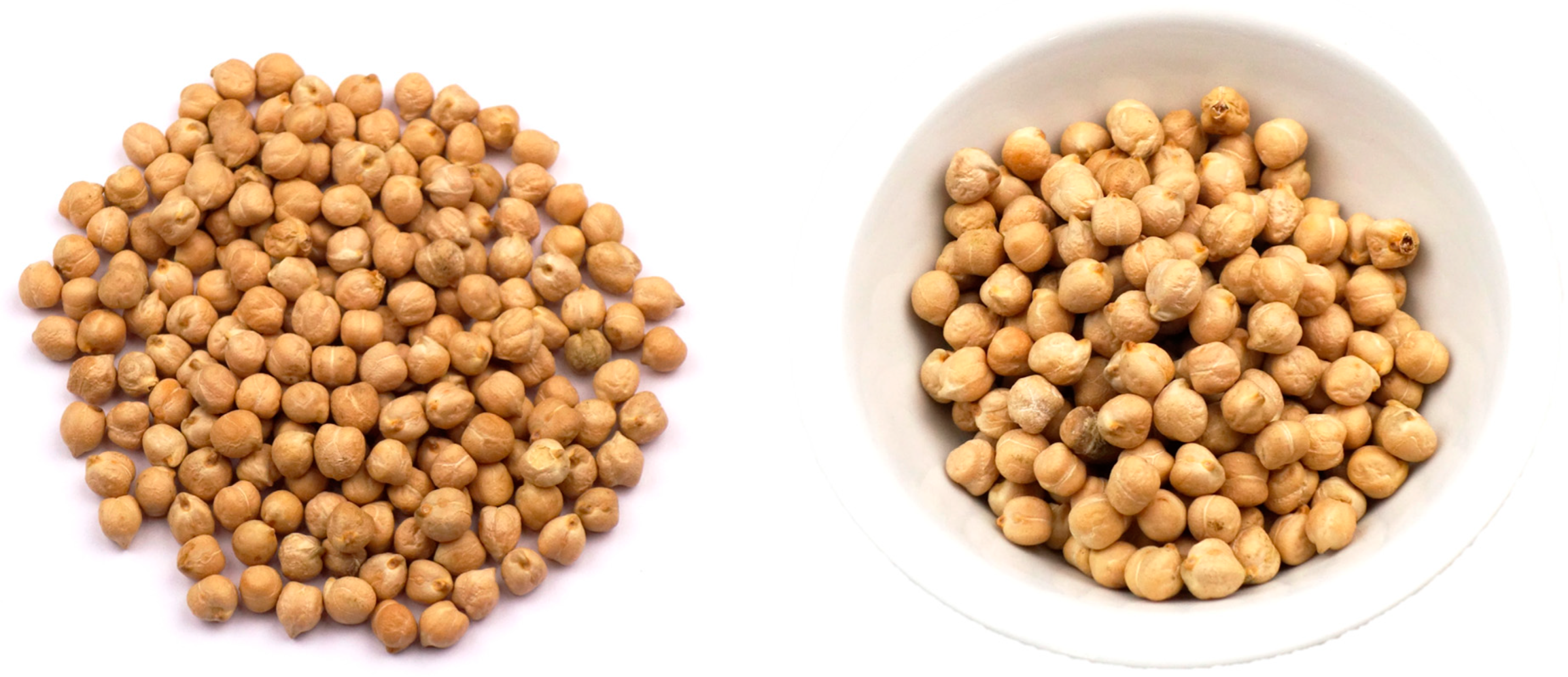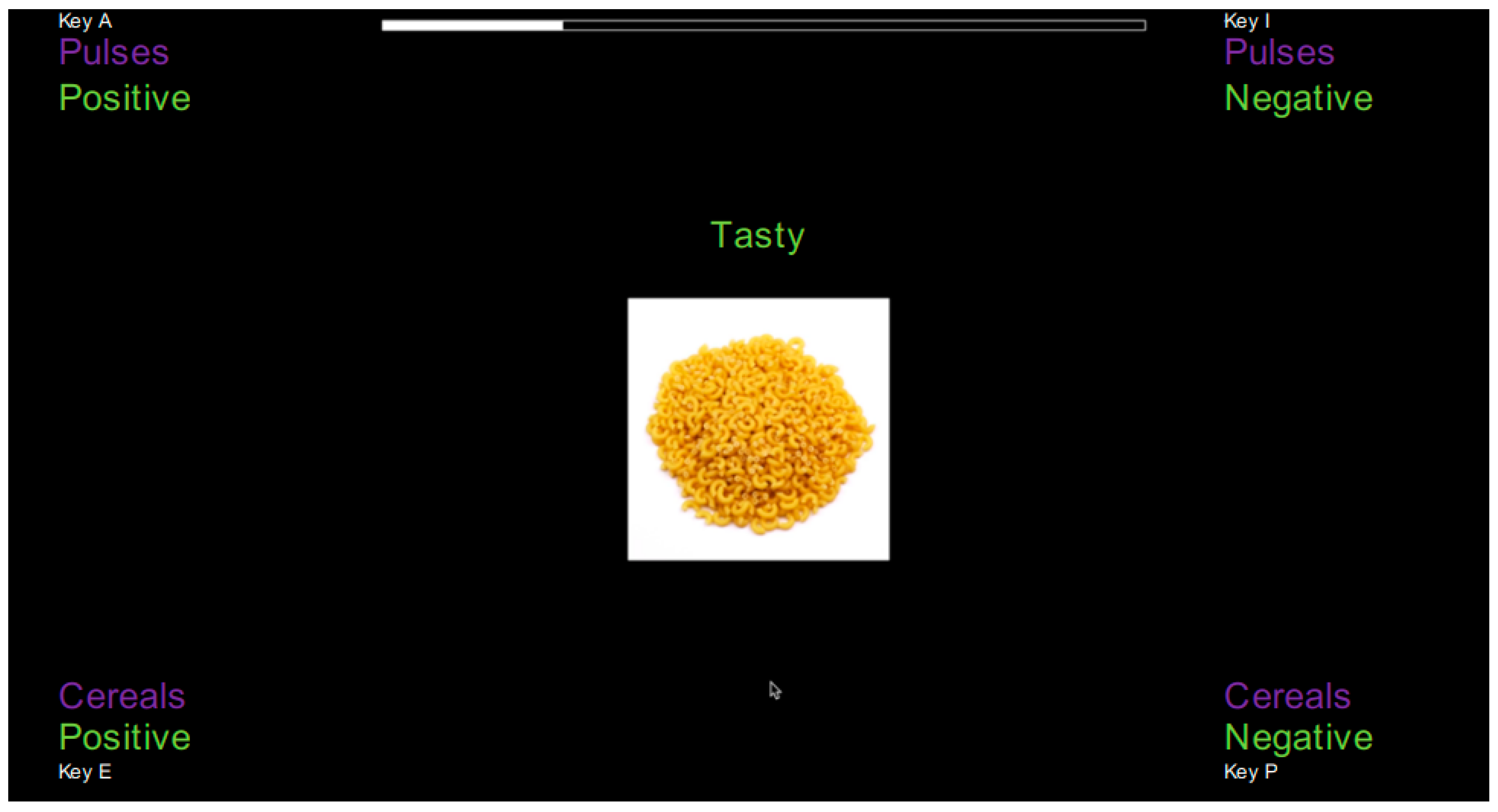Consumer Attitudes toward Pulses: Measuring the Implicit
Abstract
:1. Introduction
2. Materials and Methods
2.1. Participants
2.2. Construction of the SPF Task
2.2.1. Selection of the Stimuli
2.2.2. Structure and Measures
2.3. Statistical Analysis
2.3.1. Data Processing
2.3.2. Data Analysis
3. Results
3.1. Reaction Time for the Categorization of Paired Images and Attributes
3.2. Descriptive Results
4. Discussion
4.1. Dualism between Implicit and Explicit Attitudes toward Pulses
4.2. Perspectives: Can Consumer Behavior Be Changed despite Implicit Negative Attitudes?
5. Conclusions
Author Contributions
Funding
Institutional Review Board Statement
Informed Consent Statement
Data Availability Statement
Acknowledgments
Conflicts of Interest
References
- Havemeier, S.; Erickson, J.; Slavin, J. Dietary Guidance for Pulses: The Challenge and Opportunity to Be Part of Both the Vegetable and Protein Food Groups: Dietary Guidance for Pulses. Ann. N. Y. Acad. Sci. 2017, 1392, 58–66. [Google Scholar] [CrossRef] [PubMed]
- ANSES. INCA 3: Evolution Des Habitudes et Modes de Consommation, de Nouveaux Enjeux En Matière de Sécurité Sanitaire et de Nutrition; ANSES: Paris, France, 2017. [Google Scholar]
- Rawal, V.; Navarro, D. The Global Economy of Pulses; FAO: Rome, Italy, 2019; p. 190. [Google Scholar]
- Melendrez-Ruiz, J.; Buatois, Q.; Chambaron, S.; Monnery-Patris, S.; Arvisenet, G. French Consumers Know the Benefits of Pulses, but Do Not Choose Them: An Exploratory Study Combining Indirect and Direct Approaches. Appetite 2019, 141, 104311. [Google Scholar] [CrossRef] [PubMed]
- Melendrez-Ruiz, J.; Chambaron, S.; Buatois, Q.; Monnery-Patris, S.; Arvisenet, G. A Central Place for Meat, but What about Pulses? Studying French Consumers’ Representations of Main Dish Structure, Using an Indirect Approach. Food Res. Int. 2019, 123, 790–800. [Google Scholar] [CrossRef] [PubMed]
- Melendrez-Ruiz, J.; Chambaron, S.; Saldaña, E.; Monnery-Patris, S.; Arvisenet, G. Using CATA Tests to Capture Consumers’ Mental Representations Elicited by Images of Pulse-Based Food Products with Different Levels of Processing. Appetite 2022, 170, 105887. [Google Scholar] [CrossRef]
- Melendrez-Ruiz, J.; Arvisenet, G.; Laugel, V.; Chambaron, S.; Monnery-Patris, S. Do French Consumers Have the Same Social Representations of Pulses as Food Industry Professionals? Foods 2020, 9, 147. [Google Scholar] [CrossRef] [Green Version]
- PNNS, Programme National Nutrition Santé Equilibrer et Varier son Alimentation. Available online: http://www.mangerbouger.fr/Manger-Mieux/Que-veut-dire-bien-manger/Equilibrer-et-varier-son-alimentation (accessed on 16 March 2023).
- Chollet, S.; Sénécal, C.; Woelki, L.; Cortesi, A.; Fifi, V.; Arvisenet, G.; Valentin, D. How Protein Containing Foods Are Represented in Memory? A Categorization Study. Food Qual. Prefer. 2022, 96, 104381. [Google Scholar] [CrossRef]
- FAO. Crops Statistics-Concepts, Definitions and Classifications. Available online: https://www.fao.org/economic/the-statistics-division-ess/methodology/methodology-systems/crops-statistics-concepts-definitions-and-classifications/en/#:~:text=1.1%20Definition.,canary%20seed%2C%20buckwheat%20and%20triticale (accessed on 11 February 2023).
- ANSES. Étude Individuelle Nationale des Consommations Alimentaires 3(INCA 3) Edition Scientifique; ANSES: Paris, France, 2017. [Google Scholar]
- FAO. Que Sont Les Legumineuses? In Legumineuses: Des Graines Nutritives Pour un Avenir Durable; FAO: Rome, Italy, 2016; ISBN 978-92-5-209463-0. [Google Scholar]
- Agreste. Alimentation. Consommation Alimentaire (Quantité); Le Service statistique ministériel de l’agriculture: Paris, France, 2022; pp. 118–120. [Google Scholar]
- Shepherd, R. Does Taste Determine Consumption? Understanding the Psychology of Food Choice. In Food, People and Society: A European Perspective of Consumers’ Food Choices; Frewer, L.J., Risvik, E., Schifferstein, H., Eds.; Springer: Berlin/Heidelberg, Germany, 2001; ISBN 978-3-662-04601-2. [Google Scholar]
- Engel, J.F.; Blackwell, R.D.; Miniard, P.W. Consumer Behavior, 6th ed.; Dryden Press: Chicago, IL, USA, 1990; ISBN 978-0-03-022979-4. [Google Scholar]
- Eagly, A.H.; Chaiken, S. The Psychology of Attitudes; Harcourt Brace Jovanovich College Publishers: Orlando, FL, USA, 1993; ISBN 0-15-500097-7. [Google Scholar]
- Köster, E.P. The Psychology of Food Choice: Some Often Encountered Fallacies. Food Qual. Prefer. 2003, 14, 359–373. [Google Scholar] [CrossRef]
- Thomson, D.M.H.; Coates, T. Recent Developments in Conceptual Profiling. In Methods in Consumer Research, Volume 1; Elsevier: Amsterdam, The Netherlands, 2018; pp. 297–327. ISBN 978-0-08-102089-0. [Google Scholar]
- Nosek, B.A.; Hawkins, C.B.; Frazier, R.S. Implicit Social Cognition: From Measures to Mechanisms. Trends Cogn. Sci. 2011, 15, 152–159. [Google Scholar] [CrossRef]
- Gawronski, B.; Payne, B.K. (Eds.) Handbook of Implicit Social Cognition: Measurement, Theory, and Applications; Guilford Press: New York, NY, USA, 2010; ISBN 978-1-60623-673-4. [Google Scholar]
- Mas, M.; Brindisi, M.-C.; Chabanet, C.; Nicklaus, S.; Chambaron, S. Weight Status and Attentional Biases Toward Foods: Impact of Implicit Olfactory Priming. Front. Psychol. 2019, 10, 1789. [Google Scholar] [CrossRef] [Green Version]
- Trendel, O.; Warlop, L. Présentation et Applications Des Mesures Implicites de Restitution Mémorielle En Marketing. Rech. Appl. Mark. 2005, 20, 77–104. [Google Scholar] [CrossRef] [Green Version]
- Uhlmann, E.L.; Leavitt, K.; Menges, J.I.; Koopman, J.; Howe, M.; Johnson, R.E. Getting Explicit About the Implicit: A Taxonomy of Implicit Measures and Guide for Their Use in Organizational Research. Organ. Res. Methods 2012, 15, 553–601. [Google Scholar] [CrossRef] [Green Version]
- Bar-Anan, Y.; Nosek, B.A.; Vianello, M. The Sorting Paired Features Task: A Measure of Association Strengths. Exp. Psychol. 2009, 56, 329–343. [Google Scholar] [CrossRef]
- Vianello, M.; Bar-Anan, Y.; Nosek, B.A. Reliability of the SPF: Test-Retest and Internal Consistency. 2008. Unpublished Manuscript. Available online: https://www.projectimplicit.net/nosek/papers/VBN.PI2007.01.pdf (accessed on 2 February 2023).
- Bar-Anan, Y.; Nosek, B.A. A Comparative Investigation of Seven Indirect Attitude Measures. Behav. Res. 2014, 46, 668–688. [Google Scholar] [CrossRef] [PubMed] [Green Version]
- Anderson, M.J. Permutation Tests for Univariate or Multivariate Analysis of Variance and Regression. Can. J. Fish. Aquat. Sci. 2001, 58, 626–639. [Google Scholar] [CrossRef]
- Frossard, J.; Renaud, O. Permutation Tests for Regression, ANOVA, and Comparison of Signals: The Permuco Package. J. Stat. Soft. 2021, 99, 1–32. [Google Scholar] [CrossRef]
- Demšar, J. Statistical Comparisons of Classifiers over Multiple Data Sets. J. Mach. Learn. Res. 2006, 7, 1–30. [Google Scholar]
- de Mendiburu, F. Agricolae: Statistical Procedures for Agricultural Research 2020. Available online: https://cran.r-project.org/web/packages/agricolae/agricolae.pdf (accessed on 22 March 2023).
- Pohlert, T. The Pairwise Multiple Comparison of Mean Ranks Package (PMCMR). R Package 2014, 27, 9. [Google Scholar]
- De Boeck, P.; Jeon, M. An Overview of Models for Response Times and Processes in Cognitive Tests. Front. Psychol. 2019, 10, 102. [Google Scholar] [CrossRef] [Green Version]
- Evans, A.M.; Dillon, K.D.; Rand, D.G. Fast but Not Intuitive, Slow but Not Reflective: Decision Conflict Drives Reaction Times in Social Dilemmas. J. Exp. Psychol. Gen. 2015, 144, 951–966. [Google Scholar] [CrossRef] [Green Version]
- Coricelli, C.; Foroni, F.; Osimo, S.A.; Rumiati, R.I. Implicit and Explicit Evaluations of Foods: The Natural and Transformed Dimension. Food Qual. Prefer. 2019, 73, 143–153. [Google Scholar] [CrossRef]
- Novikov, N.A.; Nurislamova, Y.M.; Zhozhikashvili, N.A.; Kalenkovich, E.E.; Lapina, A.A.; Chernyshev, B.V. Slow and Fast Responses: Two Mechanisms of Trial Outcome Processing Revealed by EEG Oscillations. Front. Hum. Neurosci. 2017, 11, 218. [Google Scholar] [CrossRef] [Green Version]
- Krosnick, J.A. Response Strategies for Coping with the Cognitive Demands of Attitude Measures in Surveys. Appl. Cogn. Psychol. 1991, 5, 213–236. [Google Scholar] [CrossRef]
- Wilson, T.D.; Lindsey, S.; Schooler, T.Y. A Model of Dual Attitudes. Psychol. Rev. 2000, 107, 101–126. [Google Scholar] [CrossRef] [Green Version]
- Brannon, S.M.; Gawronski, B. Attitudes and the Implicit-Explicit Dualism. In The Handbook of Attitudes; Routledge, Taylor & Francis group: New York, NY, USA, 2019; pp. 158–196. ISBN 978-1-351-71239-2. [Google Scholar]
- Mandelbaum, E. Attitude, Inference, Association: On the Propositional Structure of Implicit Bias: Attitude, Inference, Association. Noûs 2016, 50, 629–658. [Google Scholar] [CrossRef]
- Strack, F.; Deutsch, R. Reflective and Impulsive Determinants of Social Behavior. Pers. Soc. Psychol. Rev. 2004, 8, 220–247. [Google Scholar] [CrossRef] [Green Version]
- Hagger, M.S.; Cameron, L.D.; Hamilton, K.; Hankonen, N.; Lintunen, T. (Eds.) The Handbook of Behavior Change, 1st ed.; Cambridge University Press: Cambridge, UK, 2020; ISBN 978-1-108-67731-8. [Google Scholar]
- Brecic, R.; Gorton, M.; Cvencek, D. Development of Children’s Implicit and Explicit Attitudes toward Healthy Food: Personal and Environmental Factors. Appetite 2022, 176, 106094. [Google Scholar] [CrossRef] [PubMed]
- Serenko, A.; Turel, O. A Dual-Attitude Model of System Use: The Effect of Explicit and Implicit Attitudes. Inf. Manag. 2019, 56, 657–668. [Google Scholar] [CrossRef]
- ANSES. Actualisation des Repères du Pnns: Révision des Repères de Consommations Alimentaires; ANSES: Paris, France, 2016; p. 54. [Google Scholar]
- Gallucci, A.; Del Mauro, L.; Pisoni, A.; Lauro, L.J.R.; Mattavelli, G. A Systematic Review of Implicit Attitudes and Their Neural Correlates in Eating Behaviour. Soc. Cogn. Affect. Neurosci. 2021, 18, nsaa156. [Google Scholar] [CrossRef] [PubMed]
- Lowery, B.S.; Hardin, C.D.; Sinclair, S. Social Influence Effects on Automatic Racial Prejudice. J. Personal. Soc. Psychol. 2001, 81, 842–855. [Google Scholar] [CrossRef]
- Lebens, H.; Roefs, A.; Martijn, C.; Houben, K.; Nederkoorn, C.; Jansen, A. Making Implicit Measures of Associations with Snack Foods More Negative through Evaluative Conditioning. Eat. Behav. 2011, 12, 249–253. [Google Scholar] [CrossRef]
- Jones, C.R.; Olson, M.A.; Fazio, R.H. Evaluative Conditioning. In Advances in Experimental Social Psychology; Elsevier: Amsterdam, The Netherlands, 2010; Volume 43, pp. 205–255. ISBN 978-0-12-380946-9. [Google Scholar]
- Bandura, A.; Walters, R.H.; Bandura, A.; Walters, R.H. Social Learning Theory; Prentice Hall: Englewood Cliffs, NJ, USA, 1977; Volume 1. [Google Scholar]
- Sechrist, G.B.; Stangor, C. Perceived Consensus Influences Intergroup Behavior and Stereotype Accessibility. J. Pers. Soc. Psychol. 2001, 80, 645–654. [Google Scholar] [CrossRef] [PubMed]
- Thaler, R.H.; Sunstein, C.R. Nudge: Improving Decisions about Health, Wealth, and Happiness; Yale University Press: New Haven, CT, USA, 2008; ISBN 978-0-300-12223-7. [Google Scholar]
- Thaler, R.H.; Sunstein, C.R.; Balz, J.P. Choice Architecture. SSRN J. 2010, 25, 428–439. [Google Scholar] [CrossRef]
- Purnhagen, K.; van Kleef, E. Commanding to “Nudge” via the Proportionality Principle? A Case Study on Diets in EU Food Law. In Regulating and Managing Food Safety in the EU; Bremmers, H., Purnhagen, K., Eds.; Springer International Publishing: Cham, Switzerland, 2018; pp. 151–167. ISBN 978-3-319-77043-7. [Google Scholar]
- van Kleef, E.; Seijdell, K.; Vingerhoeds, M.H.; de Wijk, R.A.; van Trijp, H.C.M. The Effect of a Default-Based Nudge on the Choice of Whole Wheat Bread. Appetite 2018, 121, 179–185. [Google Scholar] [CrossRef] [PubMed]




| Characteristics | Categories | Number of Participants | Porcentage |
|---|---|---|---|
| Sex | Male | 36 | 38% |
| Female | 59 | 62% | |
| Age | 18–24 years | 7 | 8% |
| 25–34 years | 28 | 29% | |
| 35–44 years | 16 | 17% | |
| 45–54 years | 27 | 28% | |
| 55–65 years | 17 | 18% | |
| Education * | High | 47 | 49% |
| Medium | 39 | 41% | |
| Low | 9 | 10% |
| Negative | Positive | |||||||
|---|---|---|---|---|---|---|---|---|
| Product | Mean (ms) | (SD) | Errors | % | Mean (ms) | (SD) | Errors | % |
| Cereals | 3006.783 | 1909.2 | 837 | 55 | 2543.194 | 1713.0 | 668 | 48 |
| Pulses | 2870.934 | 1942.1 | 682 | 45 | 2741.291 | 1790.5 | 720 | 52 |
Disclaimer/Publisher’s Note: The statements, opinions and data contained in all publications are solely those of the individual author(s) and contributor(s) and not of MDPI and/or the editor(s). MDPI and/or the editor(s) disclaim responsibility for any injury to people or property resulting from any ideas, methods, instructions or products referred to in the content. |
© 2023 by the authors. Licensee MDPI, Basel, Switzerland. This article is an open access article distributed under the terms and conditions of the Creative Commons Attribution (CC BY) license (https://creativecommons.org/licenses/by/4.0/).
Share and Cite
Melendrez-Ruiz, J.; Arvisenet, G.; Dubot, M.; Dujourdy, L.; Chambaron, S. Consumer Attitudes toward Pulses: Measuring the Implicit. Nutrients 2023, 15, 2608. https://doi.org/10.3390/nu15112608
Melendrez-Ruiz J, Arvisenet G, Dubot M, Dujourdy L, Chambaron S. Consumer Attitudes toward Pulses: Measuring the Implicit. Nutrients. 2023; 15(11):2608. https://doi.org/10.3390/nu15112608
Chicago/Turabian StyleMelendrez-Ruiz, Juliana, Gaëlle Arvisenet, Marie Dubot, Laurence Dujourdy, and Stéphanie Chambaron. 2023. "Consumer Attitudes toward Pulses: Measuring the Implicit" Nutrients 15, no. 11: 2608. https://doi.org/10.3390/nu15112608
APA StyleMelendrez-Ruiz, J., Arvisenet, G., Dubot, M., Dujourdy, L., & Chambaron, S. (2023). Consumer Attitudes toward Pulses: Measuring the Implicit. Nutrients, 15(11), 2608. https://doi.org/10.3390/nu15112608






